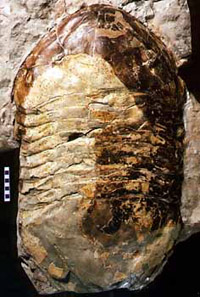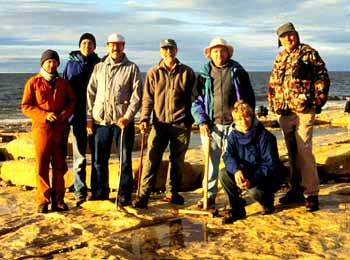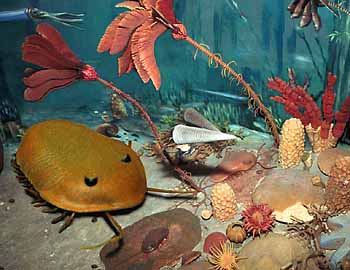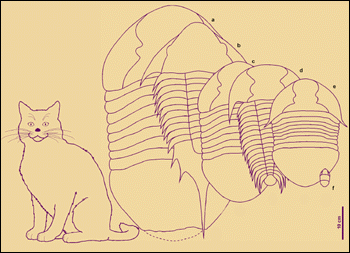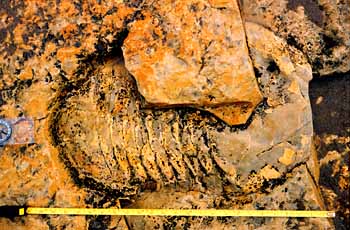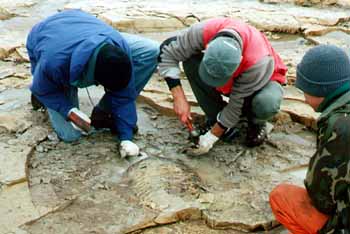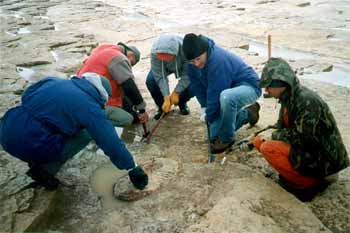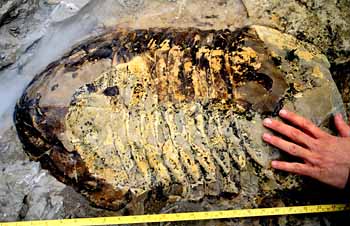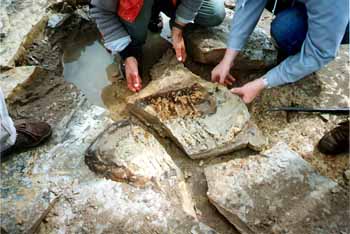 |
|||
|
|||
|
Copyright
Manitoba Museum
MANITOBA MUSEUM OF MAN & NATURE
The giant trilobite was found and recovered during a long-term field project investigating fossil life along a Late Ordovician age tropical coast.
An Ancient Giant"As a Museum, we are primarily an educational facility and this trilobite provides us with an excellent opportunity to educate our visitors about a fossil animal group other than the dinosaurs. We have found a very unusual specimen that illustrates some of the diversity and weirdness of ancient life." – Dr. Graham Young, Museum Associate Curator of Geology and Paleontology. Science is 99% hard work and 1% inspiration, and most scientists only rarely have the thrill of making a significant discovery. For the group of scientists who discovered the world's largest known trilobite, the intense excitement of uncovering this incredible specimen made the preliminary fieldwork, delicate quarrying to extract the fossil, and subsequent research and specimen preparation all worthwhile.
Measuring 72 centimetres in length, this giant trilobite is nearly 30 centimetres longer than the largest previously known to science! It also dwarfs most members of the trilobite group, typically ranging in size from three to ten centimetres.
Long before unearthing this scientific treasure embedded in Churchill's rocky shoreline, Young and Dr. Bob Elias of the University of Manitoba had been conducting preliminary fieldwork in the area. For the 1998 field season, the team included Young's associate Ed Dobrzanski, Museum Collections Manager Janis Klapecki, volunteer David Wright, University of Manitoba summer student Curtis Moffat and David Rudkin, Assistant Curator of Palaeobiology of the Royal Ontario Museum. In July of that year, the eager team of scientists set out for the northern Manitoba site. They hoped to find fossils similar to those uncovered by digs of the past, like the 43 centimetre-long trilobite excavated from the area in the 1980s.
The Excavation Process"Do you want to see something amazing?" said Rudkin with exuberance, after returning from the field area far from the rest of the group, which he had chosen for the third day of the dig. Emerging from the deposited limestone was a trilobite tail much larger than any they had seen before. "If more of it is here, this could be the biggest trilobite anywhere."As the largest known trilobite and a member of a species previously unknown to science, this specimen is truly unique. Its size contradicts the idea that larger animals are more commonly associated with colder climates. Although Churchill is now subarctic, millions of years ago when trilobites ruled the region, it was submerged in salty sea water, located on the equator and had a tropical climate.
The giant trilobite is on display in Timeless Treasures: Opening the Vaults, a stunning exhibition of unique and exotic heirlooms, archaeological artifacts, scientific specimens and rarely displayed curiosity items from the collections of the Museum and heritage organizations throughout the province.
Copyright © 2000, 2001 Manitoba Museum of Man and Nature This article may not be copied, distributed or reprinted in any form without permission from the Manitoba Museum of Man and Nature. To contact the museum, please visit their internet website, or use the e-mail address provided. Authorized reprints must acknowledge the Manitoba Museum of Man and Nature, and include the website URL address of the Manitoba Museum of Man and Nature. All images are copyright © 2000 by the Manitoba Museum of Man and Nature. Used with permission. Photographs used in this article may not be copied, distributed or reprinted in any form without permission. The preceding article was reformatted for this issue. The information in the article is also available on the Internet through the Manitoba Museum of Man and Nature website [www.manitobamuseum.mb.ca]. All photographs were provided courtesy of the Manitoba Museum of Man and Nature. This article was reprinted in the Canadian Rockhound with permission.
|
||||
 
Copyright © 2001 Canadian Rockhound
Back Issues |
News & Events |
Junior Rockhound
|
||||
